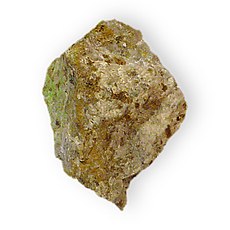Arthurite
| Arthurite | |
|---|---|
 |
|
| General | |
| Category | Arsenate minerals |
|
Formula (repeating unit) |
CuFe23+[(OH,O)(AsO4,PO4,SO4)]2·4H2O |
| Strunz classification | 8.DC.15 |
| Crystal system | Monoclinic |
| Crystal class | Prismatic (2/m) (same H-M symbol) |
| Space group | P21/c |
| Unit cell | a = 10.189(2), b = 9.649(2) c = 5.598(1) [Å] β = 92.16(2)°; Z = 2 |
| Identification | |
| Color | Apple-green to bluish-green |
| Crystal habit | Acicular, Prismatic, Spherical |
| Mohs scale hardness | 3-4 |
| Luster | vitreous |
| Streak | not reported |
| Density | D(meas.) = ~3.2 D(calc.) = 3.29 |
| Pleochroism | X = colorless to pale green; Y = gray-green; Z = olive-green |
| Dispersion | r > v |
| Absorption spectra | Z > Y > X. α = 1.736 β = 1.767 γ = 1.796 |
Arthurite is a mineral composed of divalent copper and iron ions in combination with trivalent arsenate, phosphate and sulfate ions with hydrogen and oxygen. Initially discovered by Sir Arthur Russell in 1954 at Hingston Down Consols mine in Calstock, Cornwall, England, arthurite is formed as a resultant mineral in the oxidation region of some copper deposits by the variation of enargite or arsenopyrite. The chemical formula of Arthurite is CuFe23+(AsO4,PO4,SO4)2(O,OH)2•4H2O.
Arthurite is named after Arthur W. G. Kingsbury (1906–1968), a British mineralogist, and Arthur Russell (1878–1964), 6th Baronet of Swallowfield, and a collector of minerals.
Arthurite was determined to be a uniquely new mineral by R.J. Davis and M.H. Hey in 1964 after its initial discovery. A second specimen was confirmed by A.H Clark and R.H. Sillitoe (1969) from Potrerillos, Atacama Province, Chile in 1969. Subsequently, several other arthurite-like minerals have been discovered. There are variations in which the Copper (Cu) ions are replaced with Cobalt (Co), in the case of cobaltarthurite, Manganese (Mn) replaces Cu in the case of earlshannonite, Iron (Fe) in the case of bendadaite and whitmoreite and Zinc (Zn) in the case of ojuelaite. Arthurite is the copper-dominant end-member of the Arthurite group.
...
Wikipedia
